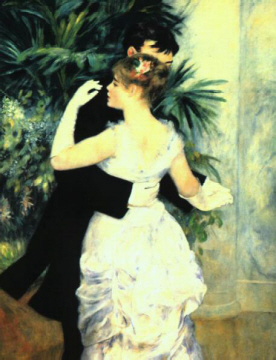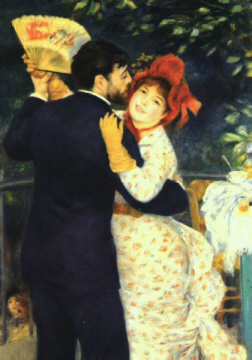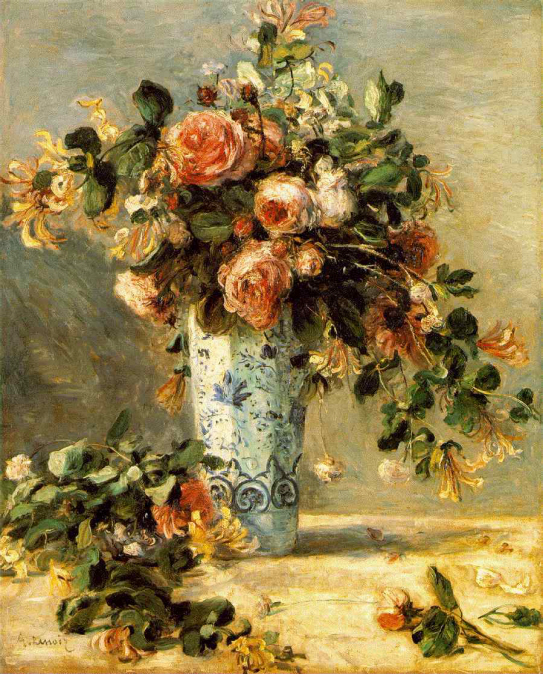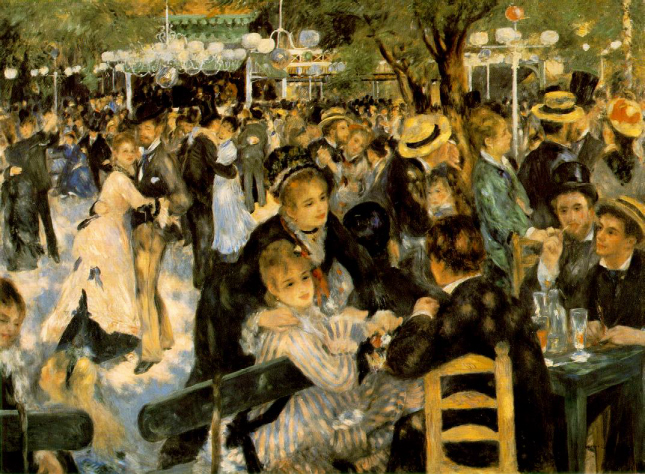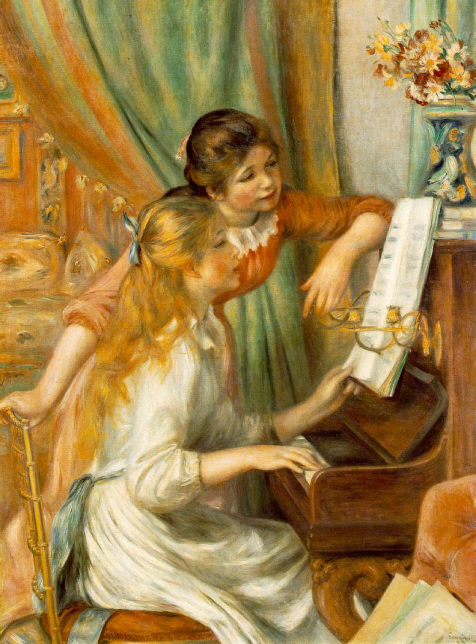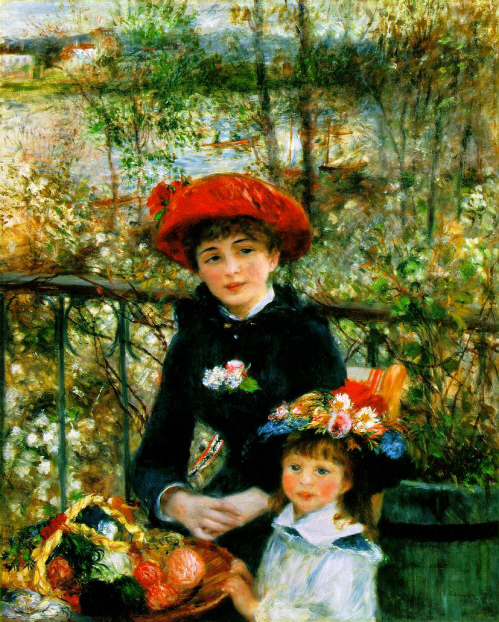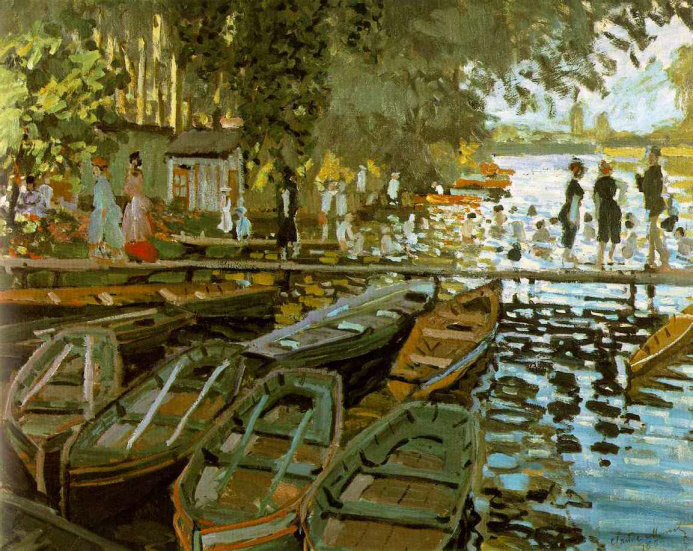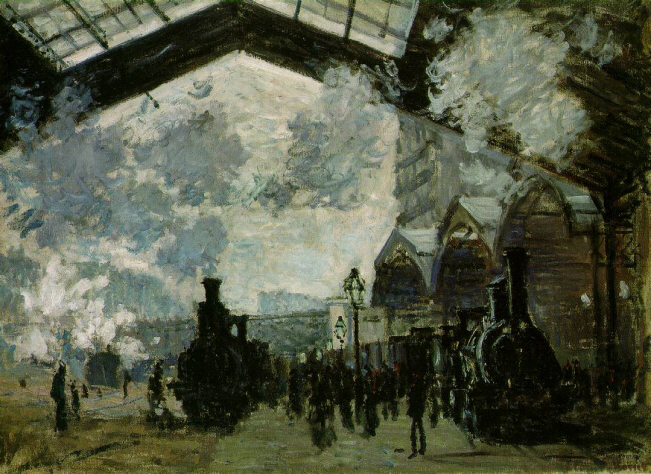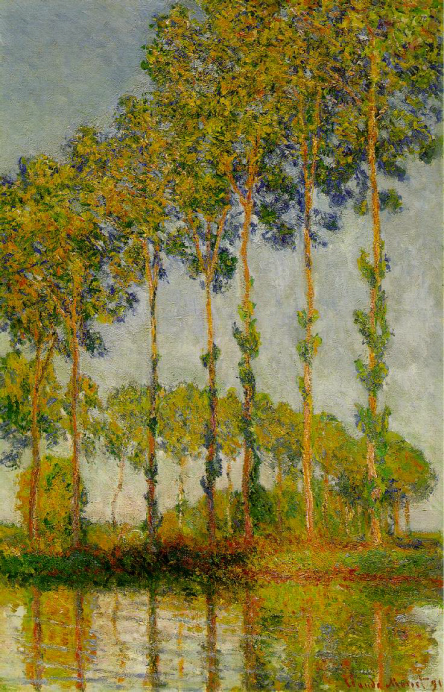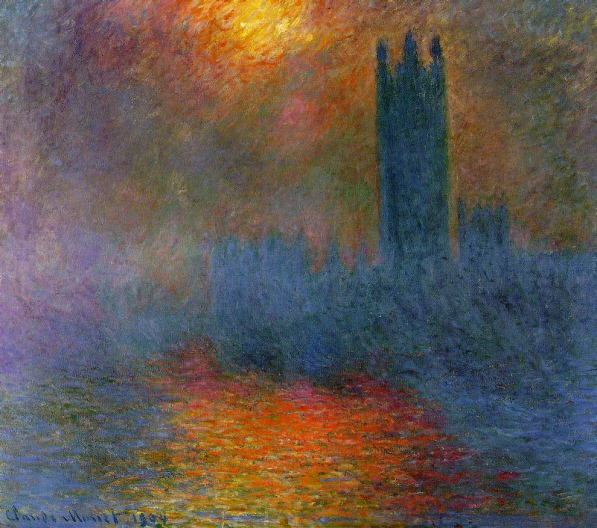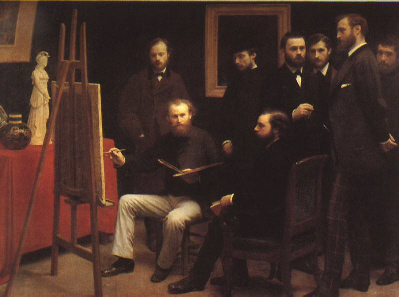
1870 ; Oil on canvas; Mus? d'Orsay, Paris
*바티뇰의 화실*An Atelier in the Batignolles
파리 몽마르트의 한 구역 이름인 '바티뇰'이라는 거리에 모여살고 있는 인상주의자들을 여러분은 만날 수 있을 것이다.
팡탕-라투르가 그려낸 이 작품은 이젤 앞에 붓을 들고 앉아있는 마네를 중심으로 그 뒤에 독일 화가인 숄데레가 서 있고, 작가 이스트루가 초상화를 모델로 의자에 앉아있다.
그리고 그 옆 왼쪽으로부터 르누아르, 졸라, 에드몽 메트르, 바질, 모네가 서있다.
이번 파리 오르세이 미술관에서 자세히 보고왔다.
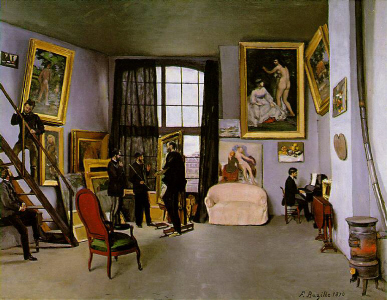
9 rue de la Condamine
1870; Oil on canvas, 98 x 128.5 cm (38 1/2 x 50 1/2 in); Musee d'Orsay, Paris
*바질르의 스튜디오*
작가들은 스튜디오를 공개하는 것을 꺼리기도 하는 반면, 일반인들이 궁금할 것을 알고 이렇듯 사실적으로 보여준다.
후에 나올 쿠르베의 스튜디오와 비교해볼 수 있는 작품이다.
꽤 높은 천정, 빛이 들어올 수 있는 넓은 창문, 그리고 때론 빛을 가릴수 있는 검은 색 커튼까지... 자세히 그의 스튜디오를 표현하고 있다.
이젤 앞에서 아마도 그 그림에 관심을 갖는 후원자에게 그림에 관하여 소개를 하는 장면인 것 같은 분위기를 알 수 있다.
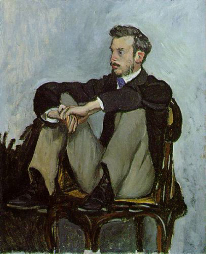
Frederic
1867 ; Oil on canvas, 122 x 107 cm (37 x 32 1/3 in)
Musee d'Orsay, Paris
*르느아르의 초상*
르느아르의 그림을 사랑하는 이들이라면 한번 쯤 궁금해 보았을 르느와르의 모습. 그렇게도 부드럽고 말랑말랑한 살결을 가진 여인들을 그려낼 수 있는 이의 모습을 알려주고 싶은 마음에... 어찌보면 그는 피카소가 원하는 모습이다. 큰 키와 적당한 체구, 멋진 코수염, 이지적인 이목구비, 샤프한 외모로 아름다운 여인들과 마음껏 사랑할 수 있고, 때로는 그 여인들을 애태울 수 있는 바람둥이의 모습. 이것이 바로 피카소가 원하는 그의 이상형이 아닌가?
르느아르는 항상 아름다운 주제와 누드의 무한한 색변화를 즐겨 그렸으며 "나는 여인의 살결이 살아서 진동하는 듯한 효과를 낼 때까지 계속 붓을 움직인다" 고 말한 장본인이다.
Degas, (Hilaire-Germain-) Edgar
c. 1872 (120 Kb); Oil on canvas, 36.5 x 55.9 cm (14 3/8 x 22"); Museum of Fine Arts, Boston
절반은 그림안에, 절반은 그림밖에 -마치 사진기의 뷰파인더도 들려다보지 않고 재빠르게 사진을 찍은 것 처럼 보인다. 주제는 어디에??
Place de la Concorde
1875 (250 Kb); Oil on ca nvas, 78.4 x 117.5 cm (30 7/8 x 46 1/4 in); No. 3K 1399; Formerly collection Gerstenberg/Scharf, Berlin; Hermitage, St Petersburg
드가의 독특한 풍경 구도는 사진에서 오는 구도로 과감히 자르거나 일부러 집어넣거나 하면서 화면을 좀 더 크게 만드는 효과를 가져왔다. 그것은 어설프지도 않았고, 그 와중에도 그의 색채는 빛을 담고 있어 우리로 하여금 3차원의 공간과 완벽한 구도를 상상하게 만드는 훌륭한 작품으로 탄생시켰다.
Race Horses
1885-88 (100 Kb); Pastel on panel, 11 7/8 x 16 in; Philadelphia Museum of Art
경마장에서 보여지는 특별한 점은 중첩의 효과이다. 앞에 말 뒤에 말, 그리고 그 뒤에 말들이 계속해서 중첩되면서 자연스러운 원근법과 깊은 공간을 만들어내고 있다.
n.d. (80 Kb); Paper, 6 1/2 x 8 1/4 in; Barnes Foundation
Photograph by Charalambos Amvrosiou
Edgar Degas. Orchestra Musicians. 1870-71. Oil on canvas. Stadtische Galerie im Stadelschen Kunsstinstitut, Frankfurt am Main, Germany.
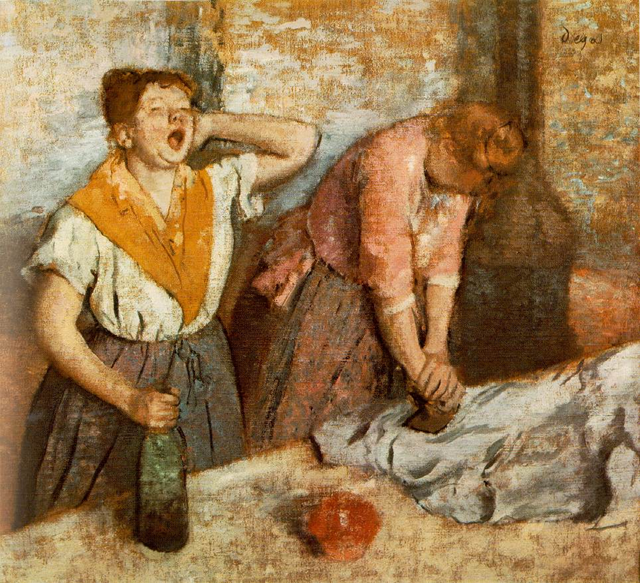
세탁부-여자들에게 다림질이란 힘든 일, 일상의 나른한 피곤함,어둡고 가난한 이웃들의 삶의 현장을 이야기거리로...
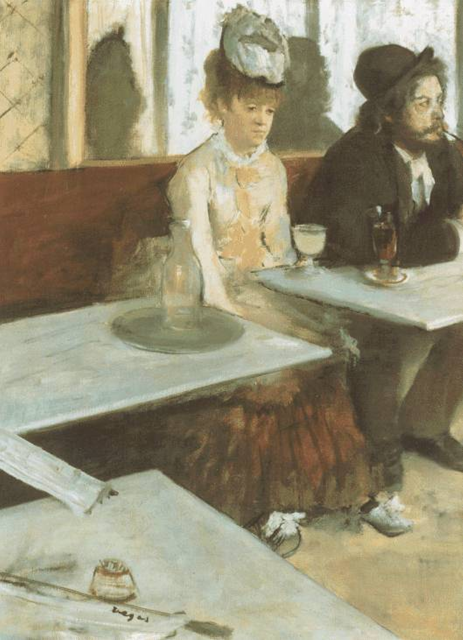
The Absinthe Drinker. 1875-76. Oil on canvas. Musée d'Orsay, Paris, France.
인상주의 화가들이 풍경그리는 일에 몰두했을때, 드가는 일상적인 풍경과 무대의 발레리나들이 그의 가장 아름다운 주제가 되었다.
Renoir, Pierre-Auguste
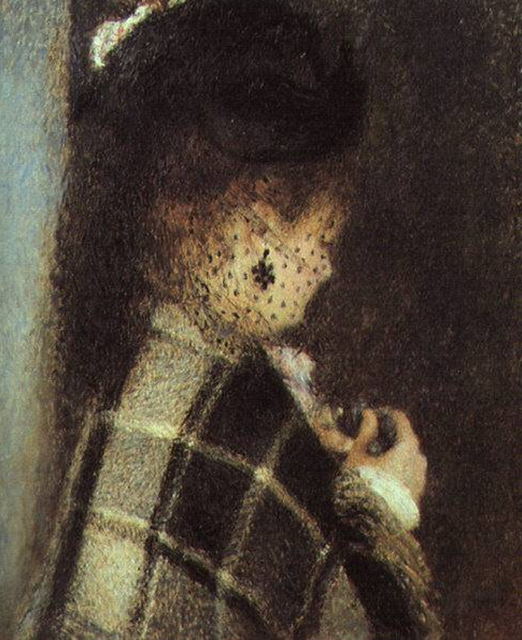
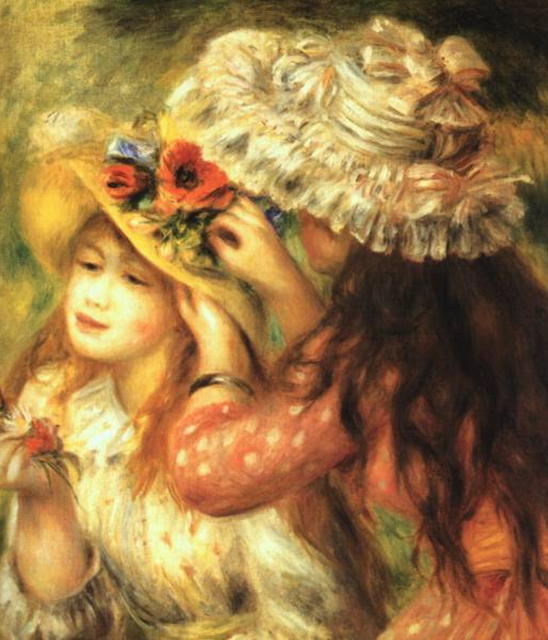
MOulin de la Galette
1876 (170 Kb); Oil on canvas, 131 x 175 cm; Mus? d'Orsay르느와르는 이 작품에서 색을 빽빽히 칠하지 않았다. 그러므로써, 사람들의 춤추는 동작이 살아나고, 흥겨움 파티 분위기가 멈춰지지 않고 살아있는 듯한 느낌으로 그 분위기를 생생히 전달해 주고 있다.
르느와르는 검은 색을 쓰지 않고, 겁푸른 색으로 그것을 대신했다.
검은색은 캔버스가 뚫어진 것 같이 보이기 때문이라고 전한다.
Renoir delighted in `the people's Paris', of which the Moulin de la Galette near the top of Montmartre was a characteristic place of entertainment, and his picture of the Sunday afternoon dance in its acacia-shaded courtyard is one of his happiest compositions. In still-rural Montmartre, the Moulin, called `de la Galette' from the pancake which was its speciality, had a local client?e, especially of working girls and their young men together with a sprinkling of artists who, as Renoir did, enjoyed the spectacle and also found unprofessional models. The dapple of light is an Impressionist feature but Renoir after his bout of plein-air landscape at Argenteuil seems especially to have welcomed the opportunity to make human beings, and especially women, the main components of picture. As Manet had done in La Musique aux Tuileries he introduced a number of portraits.
The girl in the striped dress in the middle foreground (as charming of any of Watteau's court ladies) was said to be Estelle, the sister of Renoir's model, Jeanne. Another of Renoir's models, Margot, is seen to the left dancing with the Cuban painter, Cardenas. At the foreground table at the right are the artist's friends, Frank Lamy, Norbert Goeneutte and Georges Rivi?e who in the short-lived publication L'Impressionniste extolled the Moulin de la Galette as a page of history, a precious monument of Parisian life depicted with rigorous exactness. Nobody before him had thought of capturing some aspect of daily life in a canvas of such large dimensions.
Renoir painted two other versions of the subject, a small sketch now in the Ordrupgard Museum, near Copenhagen and a painting smaller than the Louvre version in the John Hay Whitney collection. It is a matter of some doubt whether the latter or the Louvre version was painted on the spot. Rivi?e refers to a large canvas being transported to the scene though it would seem obvious that so complete a work as the picture in the Louvre would in any case have been finished in the studio.
( b. Feb. 25, 1841, Limoges, France--d. Dec. 3, 1919, Cagnes)
French painter originally associated with the Impressionist movement. His early works were typically Impressionist snapshots of real life, full of sparkling colour and light. By the mid-1880s, however, he had broken with the movement to apply a more disciplined, formal technique to portraits and figure paintings, particularly of women (e.g. , Bathers, 1884-87).
In 1854 he began work as a painter in a porcelain factory in Paris, gaining experience with the light, fresh colors that were to distinguish his Impressionist work and also learning the importance of good craftsmanship. His predilection towards light-hearted themes was also influenced by the great Rococco masters, whose works he studied in the Louvre. In 1862 he entered the studio of Gleyre and there formed a lasting friendship with Monet, Sisley, and Bazille. He painted with them in the Barbizon district and became a leading member of the group of Impressionists who met at the Caf?Guerbois. His relationship with Monet was particularly close at this time, and their paintings of the beauty spot called La Grenouill?e done in 1869 (an example by Renoir is in the Nationalmuseum, Stockholm) are regarded as the classic early statements of the Impressionist style. Like Monet, Renoir endured much hardship early in his career, but he began to achieve success as a portraitist in the late 1870s and was freed from financial worries after the dealer Paul Durand-Ruel began buying his work regularly in 1881. By this time Renoir had 'travelled as far as Impressionism could take me', and a visit to Italy in 1881-82 inspired him to seek a greater sense of solidarity in his work. The change in attitude is seen in The Umbrellas (NG, London), which was evidently begun before the visit to Italy and finished afterwards; the two little girls on the right are painted with the feathery brush-strokes characteristic of his Impressionist manner, but the figures on the left are done in a crisper and drier style, with duller coloring. After a period of experimentation with what he called his `mani?e aigre' (harsh or sour manner) in the mid 1880s, he developed a softer and more supple kind of handling. At the same time he turned from contemporary themes to more timeless subjects, particularly nudes, but also pictures of young girls in unspecific settings. As his style became grander and simpler he also took up mythological subjects (The Judgement of Paris; Hiroshima Museum of Art; 1913-14), and the female type he preferred became more mature and ample. In the 1890s Renoir began to suffer from rheumatism, and from 1903 (by which time he was world-famous) he lived in the warmth of the south of France. The rheumatism eventually crippled him (by 1912 he was confined to a wheelchair), but he continued to paint until the end of his life, and in his last years he also took up sculpture, directing assistants (usually Richard Guino, a pupil of Maillol) to act as his hands (Venus Victorious; Tate, London; 1914).
Renois is perhaps the best-loved of all the Impressionists, for his subjects---pretty children, flowers, beautiful scenes, above all lovely women---have instant appeal, and he communicated the joy he took in them with great directness. `Why shouldn't art be pretty?', he said, `There are enough unpleasant things in the world.' He was one of the great worshippers of the female form, and he said `I never think I have finished a nude until I think I could pinch it.' One of his sons was the celebrated film director Jean Renoir (1894-1979), who wrote a lively and touching biography (Renoir, My Father) in 1962.
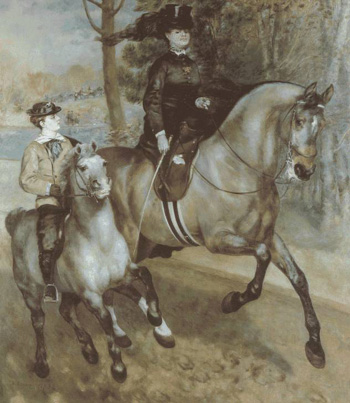
c.1873 (50 Kb); Oil on canvas, 261 x 226cm; Kunsthalle at Hamburg
안장을 받치고 말 허리를 둘러싼 밴드가 멋지다.
마치 '발리' 제품인 것 같은 생각이 들 정도로.
그것이 이 작품에서 눈에 띄는 시각적 효과를 가져다 주고 있다.
1892 (150 Kb); Oil on canvas, 116 x 90 cm (45 5/8 x 35 3/8 in); Musee d'Orsay, Paris
직접 촬영해온 르느와르의 작품이다.
이 작품에 어울리는 액자가 무엇인지 확실하게 전달하고 싶어서 이 작품을 그대로 올렸다.
색채가 어찌나 아름답던지,
잠깐동안 눈을 떼지 못했다
1881 (220 Kb); Oil on canvas, 100.5 x 81 cm (39 1/2 x 31 7/8"); The Art Institute of Chicago, Mr. and Mrs. Lewis Larned Collection
눈이 부시게 화사하고 아름다운 작품.
르느와르의 작품으로 그의 특유의 꽃, 여인, 소녀가 한데 어우러진 완벽한 작품이다.
Monet, Claude
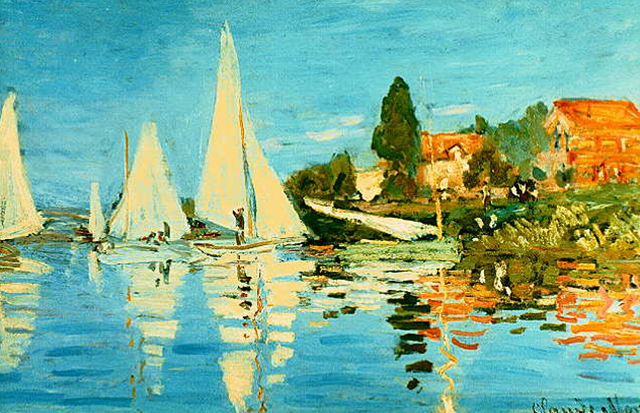
물을 보면 빛을 가장 잘 표현 할 수 있다던 모네의 작품.
여름 화창한 날 파란 하늘이 비친 살아있는 바다의 모습이다.
붓터치로 인해 생생한 현장을 느낄 수 있다.
이러한 대가의 작품들은 어색함이 없어서 좋다.
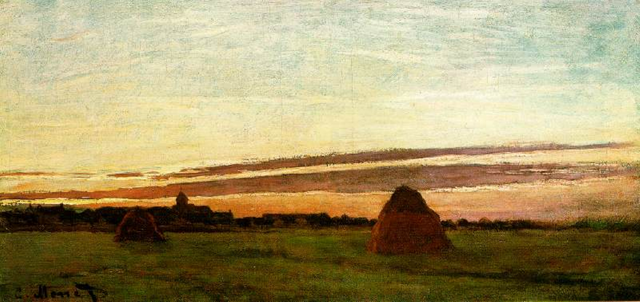
1865 (50 Kb); Oil on canvas, 30 x 60 cm (11 7/8 x 23 3/4 in); San Diego Museum of Art
This is an early work done a quarter-century before the famous Wheatstack series of 1890-91. In those later works, Monet succeeded in expressing the immutable essence of the Wheatstacks; here they are integrated into the overall landscape. The relative sizes of the Haystacks as well as the inclination of the low-lying clouds leads the eye forcefully toward the vanishing point of the rising sun. This leftward-leaning composition is accentuated by the exaggerated horizontality of the canvas. The muted colors and relatively finished brushwork, along with the pyramidal shapes of the haystacks, convey a sense of permanence that somewhat contradicts the depiction of something as transient as a sunrise. This is an important early reference point illustrating the artistic problems Monet worked to resolve as his style developed.
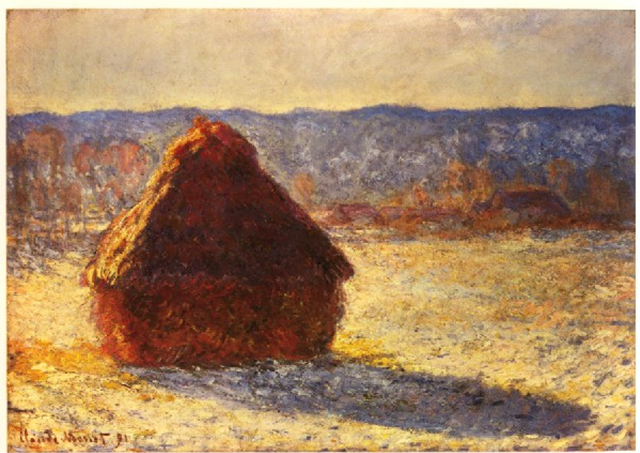
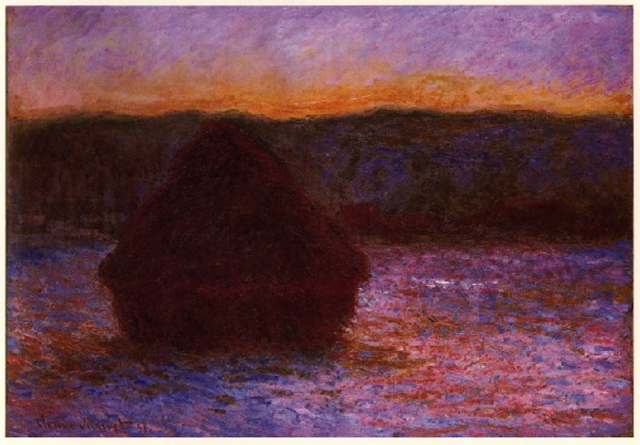
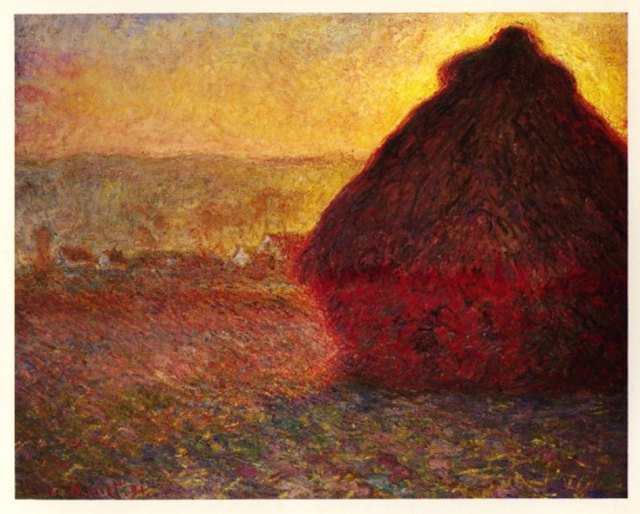
1891 (90 Kb); 73,3 x 92.6 cm; Museum of Fine Arts, Boston
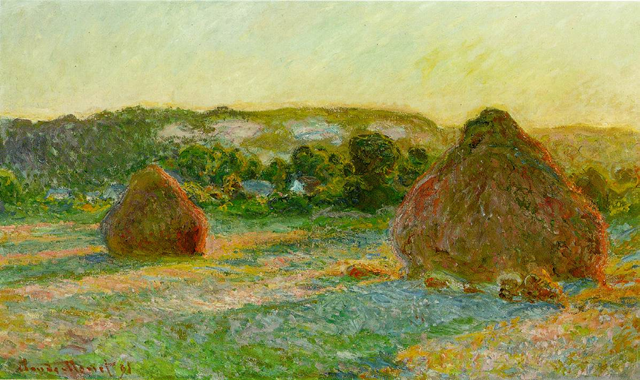
1890-91 (190 Kb); Oil on canvas, 60 x 100 cm (23 5/8 x 39 3/8 in); The Art Institute of Chicago
1877 (180 Kb); Oil on canvas, 54.3 x 73.6 cm (21 3/8 x 29 in); National Gallery, London
19세기 발명품 증기기관차. 증기기관차가 증기를 붐어내면 천정가득히 흩어지면서 만들어내는 순간적인 빛의 효과에 시시때때 변화하는 순간을 포착하여 그렸다.

1891; Philadelphia Museum of Art
1891 (260 Kb); Oil on canvas, 100 x 65 cm (39 3/8 x 25 5/8 in); Private collection
Monet painted the tall poplars on the banks of the river Epte near his house at Giverny under varying climatic and seasonal conditions in 1890 and again in 1891. A row of tall vertical stems backed by a receding line of other poplars provided the basic arrangement which he observed from his boat. He began his series of Haystacks before he had finished with the Poplars, a distant line of trees often forming a background. In both series he took enormous pains to wait for and entrap exactly the light each picture demanded. Yet in spite of the stubborn effort made with the aim of attaining a complete objective truth, causing him to take out a whole set of canvases to the chosen site on which he could work one at a time as a particular phase of light allowed, another element insidiously crept in. The subject in constant repetition came to matter less and less; aesthetic considerations apart from a scientific naturalism came into play. The slenderness of the poplars seemed to take on something of the exaggerated elegance of the contemporaneous art nouveau. The color scheme became more of a contrived and artificially heightened contrast between blues and purples, oranges and yellows. The new aspect of Monet's art after he had reached the age of fifty can be appreciated in the ecstatic color of this example.
With the public the series were a great success, the Haystacks especially. Fifteen of them exhibited at Durand-Ruel's were all sold within a few days at 3,000 to 4,000 francs each. But there were some critics and some among Monet's Impressionist
confrères who were dubious of the course he now pursued. The adverse opinion gained strength that Impressionism so interpreted involved too great a sacrifice of substance and construction. Yet they attached too little value to the poetic and abstract characteristics of Monet's art.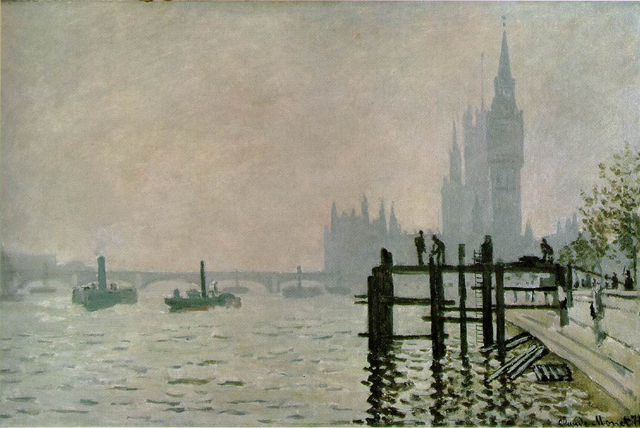
The Thames at Westminster (Westminster Bridge)
1871 (130 Kb); Oil on canvas, 47 x 72.5 cm (18 1/2 x 28 1/2"); Collection Lord Astor of Hever; National Gallery, London
Houses of Parliament, London, Sun Breaking Through the Fog
1904 (190 Kb); Oil on canvas, 81 x 92 cm (31 7/8 x 36 1/4 in); Musee d'Orsay, Paris
Le Parlement, Effet de Brouillard
1904 (120 Kb); 82.6 x 92.7 cm; Museum of Fine Arts, St. Petersburg
Houses of Parliament, London
1905 (50 Kb); Oil on canvas, 81 x 92 cm (31 7/8 x 36 1/4 in); Musee Marmottan, Paris
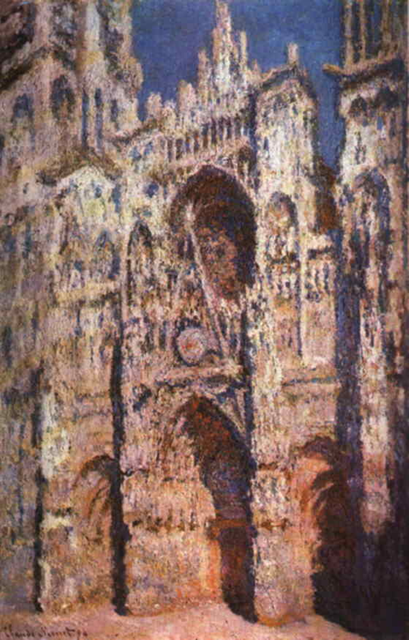
1894; Louvre, Paris
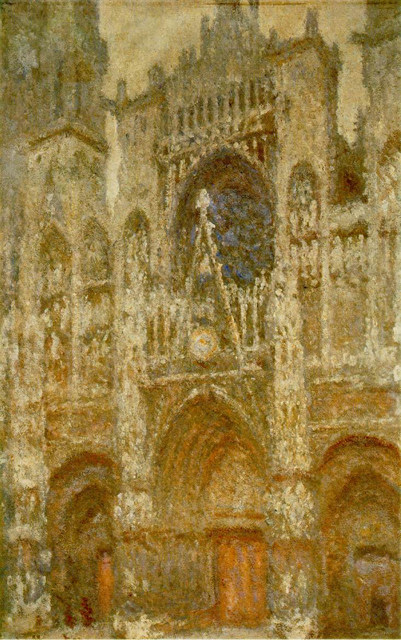
dated 1894, painted 1892 (200 Kb); Oil on canvas, 100 x 65 cm (39 3/8 x 25 5/8 in); Musee d'Orsay, Paris
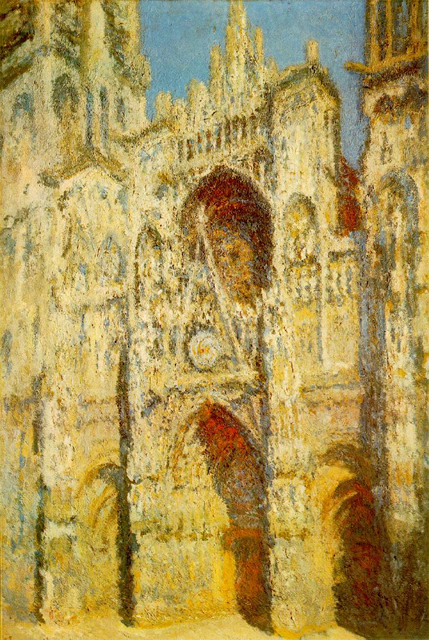
dated 1894, painted 1893 (240 Kb); Oil on canvas, 107 x 73 cm (42 1/8 x 28 3/4 in); Musee d'Orsay, Paris
Monet's persistence in painting in series, beginning with the Gare Saint-Lazare and continuing in the Poplars and Haystacks, attains an impressive climax in the series he devoted to Rouen Cathedral. He began work at Rouen early in 1892, the year after he had finished the Haystacks and the last of the Poplars, and took a room above a shop in the rue Grand-Pont from which to observe the west front of the great church. He broke off to return to Giverny but resumed work at Rouen in the spring of 1893. The rest of that year and most of 1894 was spent in completing the paintings from memory. Twenty of them, ranging in effect from dawn to sunset, were exhibited at Durand-Ruel's gallery in 1895 with great success. Monet's friend Clemenceau justly praised their `symphonic splendour'. Pissarro reproved adverse criticism in the letter to his son in which he remarked on the series as `the work, well thought out, of a man with a will of his own, pursuing every nuance of elusive effects, such as no other artist that I can see has captured'.
Monet, it is clear, was as little concerned with the subject, masterpiece of Gothic architecture though it was, as when painting his Haystacks. Where the building invited and challenged his ability was in the fretting of the surface as it caught the light and the profound effects of shadow in the deep recesses. The heavy grain of his thick paint gave its own animation to the façade. Working largely from memory he exchanged the more fluent technique of the plein-air picture finished at a sitting for this entirely opposite quality of carefully worked-up impasto. In addition, without direct reference to the building in reality, a poetic element in his nature seems to have come uppermost. There remains the sensation of Gothic without its detail curiously similar to that of Gaudi's Church of the Holy Family at Barcelona (mainly built about the same time as Monet was painting his Cathedrals)--another instance perhaps of the subtle and far-reaching influence of art nouveau. Otherwise, rather than conveying the atmospheric reality of sunlight, a painting such as the example given here can be appreciated as a gorgeous dream.
1876; Museum of Fine Arts, Boston
부채를 들고 기모노를 입고 요염한 포즈를 하고 있는 일본 여인.
빨간 색의 의상과 대비되는 회색 빛의 벽에는 동그란 부채가 장식적으로 표현되었다. 기모노의 의상에는 일본 남성의 모습이 그려져있다. 여인의 서있는 포즈는 예사롭지 않은 어려운 포즈이지만 우리를 향해 웃고있는 얼굴은 앳되보인다. 바닥에도 부채가 떨어져있고, 바닥은 일본 정통 바닥인 듯 보인다.
모네가 그린 일본여인의 모습은 이 싸이트를 만들다가 발견한 것이다.
1868; Louvre, Paris
모네의 인물화. 귀족계급의 아름다운 여인이 고급스런 실내인테리어 안속에 마치 한 폭의 그림같은 포즈로 우아한 자태를 보여준다.
여인을 그린 모네의 보기드문 작품이 아니지 않나싶다. 푸른 커텐, 붉은 쇼올, 노란 두송이 꽃이 인상적이다.
모네의 또 다른 자료~ 클릭
'History of Arts > 19C' 카테고리의 다른 글
| seurat georges 신인상주의 (4) | 2020.04.20 |
|---|---|
| Gustave Caillebotte 인상주의 (0) | 2020.04.20 |
| 낭만주의- Dante Gabriel Rossetti(1828 –1882) (2) | 2020.04.02 |
| 고야 (0) | 2020.04.02 |
| 블레이크 (0) | 2020.04.02 |









